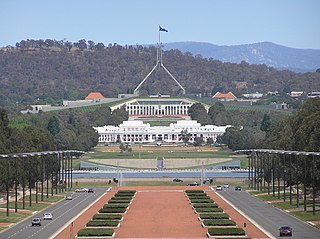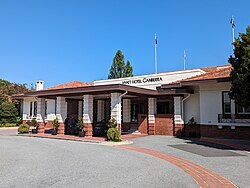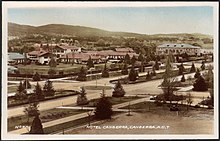
The prime minister of Australia is the head of government of the Commonwealth of Australia. The prime minister is the chair of the Cabinet of Australia and thus the head of the federal executive government. Under the principles of responsible government, the prime minister is both responsible to and a member of the Commonwealth Parliament. The current prime minister is Anthony Albanese of the Australian Labor Party, who assumed the office on 23 May 2022.

James Henry Scullin was an Australian politician and trade unionist who served as the ninth prime minister of Australia from 1929 to 1932. He held office as the leader of the Australian Labor Party (ALP), having briefly served as treasurer of Australia during his time in office from 1930 to 1931. His time in office was primarily categorised by the Wall Street Crash of 1929 which transpired just two days after his swearing in, thus heralding the beginning of the Great Depression in Australia. Scullin remained a leading figure in the Labor movement throughout his lifetime, and was an éminence grise in various capacities for the party until his retirement from federal parliament in 1949. He was the first Catholic, as well as the first Irish-Australian, to serve as prime minister.

The Lodge is the primary official residence of the prime minister of Australia. Located at 5 Adelaide Avenue in the Canberra suburb of Deakin, it is situated a short distance away from Parliament House. The Lodge is one of two official prime ministerial residences, the secondary official residence being Kirribilli House in Sydney. The building was completed in 1927 in the Georgian revival style, since then twenty-three people have served as prime minister, six of whom chose to live elsewhere either full- or part-time during their tenure, and two who chose to live at Kirribilli House.

Government House, colloquially known as Yarralumla, is the official residence of the governor-general of Australia. It is located in the suburb of Yarralumla in the Australian capital city of Canberra, in the Australian Capital Territory. The main residence is set amid 54 hectares of parkland. The house and its associated grounds were added to the Commonwealth Heritage List on 22 June 2004.

Parliament House, also known as Capital Hill, is the meeting place of the Parliament of Australia, the legislative body of Australia's federal system of government. The building also houses the core of the executive branch of the Australian Government, and contains the Cabinet room and offices of the Prime Minister and other federal ministers.

John Lawrence Baird, 1st Viscount Stonehaven, was a British politician who served as the eighth Governor-General of Australia, in office from 1925 to 1930. He had previously been a government minister under David Lloyd George, Bonar Law, and Stanley Baldwin.
The history of Canberra details the development of the city of Canberra from the time before European settlement to the city's planning by the Chicago architect Walter Burley Griffin in collaboration with Marion Mahony Griffin, and its subsequent development to the present day.

Yarralumla is a large inner south suburb of Canberra, the capital city of Australia. Located approximately 3.5 km (2.2 mi) south-west of the city, Yarralumla extends along the south-west bank of Lake Burley Griffin from Scrivener Dam to Commonwealth Avenue.

Deakin is a suburb of Canberra, Australian Capital Territory, Australia. Development began in the 1920s, although the vast majority of the suburb was built after 1945. It is a largely residential suburb. It includes The Lodge, and the Royal Australian Mint.

Reid is a suburb of Canberra, Australian Capital Territory, Australia. With a population of 1,544 at the 2021 census, located directly next to Civic, Reid is one of the oldest suburbs in Canberra. It is named after George Reid, the fourth prime minister of Australia.

Barton is a suburb of Canberra, Australian Capital Territory, Australia. At the 2021 census, Barton had a population of 1,946 people.
South Canberra, or the Inner South, is a subdivision of Canberra Central in the Australian Capital Territory in Australia.

Government-owned housing in Canberra and the Australian Capital Territory has a history stemming from the decision to build the National Capital in the bush. In the early years Canberra's housing was entirely government-built and even after private development took over there has been a number of government houses included in almost every new suburb. Typical Canberra public housing is built on a limited number of plans repeated through an area of a suburb, with two or three bedrooms and constructed in unfinished brick veneer. They typically range in size from around 80 m2 to 130 m2. The term Govie is a colloquialism used to describe the typical Canberran government built house.

The Albert Hall is a hall in Canberra, Australia, used for entertainment. It is on Commonwealth Avenue between Commonwealth Bridge and the Hotel Canberra in the suburb of Yarralumla.

Old Parliament House, formerly known as the Provisional Parliament House, was the seat of the Parliament of Australia from 1927 to 1988. The building began operation on 9 May 1927 after Parliament's relocation from Melbourne to the new capital, Canberra. In 1988, the Commonwealth Parliament transferred to the new Parliament House on Capital Hill. Since 2009, Old Parliament House has become a museum about the building and Australian democracy more broadly, named the Museum of Australian Democracy at Old Parliament House (MoAD). It also serves as a venue for temporary exhibitions, lectures and concerts.

Commonwealth Avenue is a major road in Canberra, Australian Capital Territory, Australia. It connects Civic with South Canberra. Specifically, it runs between City Hill and Capital Hill.

John Smith Murdoch was a Scottish architect who practised in Australia from the 1880s until 1930. Employed by the newly formed Commonwealth Public Works Department in 1904, he rose to become chief architect, from 1919 to 1929, and was responsible for designing many government buildings, most notably the Provisional Parliament House in Canberra, the home of the Parliament of Australia from 1927 to 1988.

Mercure Hotel Canberra, historically known as the Hotel Ainslie and Olims is a historic, four star hotel located in the inner Canberra suburb of Braddon, Australian Capital Territory. It is the closest major hotel to the Australian War Memorial and is located on Limestone Avenue. The Hotel Ainslie has been listed on the Australian Institute of Architects' Register of Significant Twentieth Century Architecture since 1984 due to its significance as a rare late example of English Arts and Crafts architecture and was previously listed in the now defunct Register of the National Estate. It is listed on the ACT Heritage Register.

Hotel Kurrajong Canberra is a heritage-listed hotel located in the Canberra suburb of Barton, Australian Capital Territory, close to Parliament House and national institutions within the Parliamentary Triangle precinct. The Hotel has a strong association with Australia's political history, most notably as the residence of Prime Minister Ben Chifley throughout his parliamentary career, including his term in office from 1945-1949. In 1951, Chifley suffered a fatal heart attack in room 205 at Hotel Kurrajong.

Gorman House in Braddon, Australian Capital Territory is an Art Deco landmark house located in inner Canberra. It operated as a hostel from 1924 until 1972 and has subsequently become a popular centre for theatre and the creative arts in fields such as photography, dance, acting and music. It is listed on the National Heritage Register which describes it as "a fine and externally intact example of John Smith Murdoch's garden pavilion style, which makes a creditable contribution to the townscape." The garden pavilion style is characterized by low buildings, covered paths and open courtyards.




















